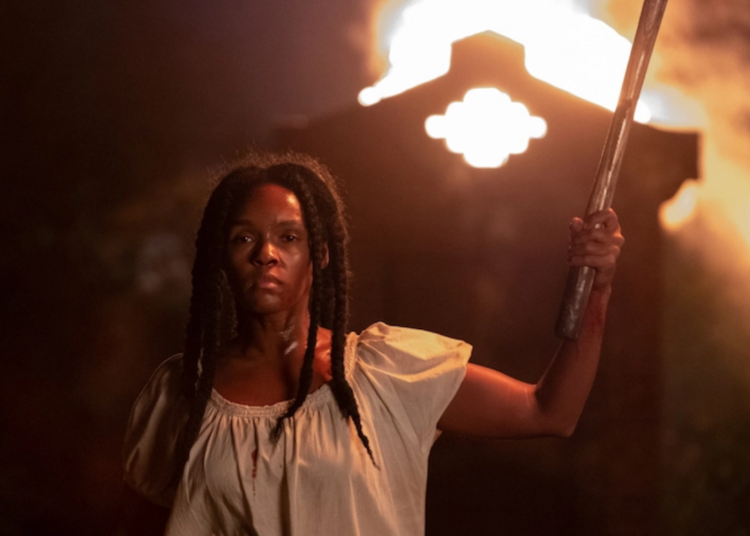TW: The following contains spoilers, descriptions of violence, racial discrimination and brutality.
On Friday the 2nd of April, Antebellum premiered in the UK. It is available on Sky Cinema TV and Now TV respectively. As curious as I am, I couldn’t resist giving it a watch. To be completely honest, I was sitting in front of my TV, having already seen some of the premieres of that day that I’ve wanted to see so, I was just casually browsing and trying to kill time. Browsing Now TV’s “Recently Added” menu, I came across this image with a pitch-black background featuring a Black woman with a blood-red butterfly across her mouth and Antebellum written to the right of her face also in blood-red colour. It reminded me of Silence of the Lambs and I was not particularly intrigued to press play and give it a go. I was convinced this would be some despicable horror film which I don’t foster any interest in. However, not having had heard of Antebellum prior and having been extremely bored, I pressed play nonetheless thinking I wouldn’t watch the whole thing anyway – just until I’d fall asleep. Little did I know it was going to be so incredibly mesmerising, intriguingly paralysing and painfully tense, that I, not only wouldn’t be able to press pause on it, let alone fall asleep long after. This film is so glass-shatteringly powerful, brutally honest and up to the point, touching brutal facts of history, that it is not only impossible to miss this film, but also irresponsible to do so.
Running through the core of this film is William Faulkner’s quote from Requiem for a Nun: “The past is never dead. It’s not even past” and it reminds us that we should not lightheartedly disregard past lessons and leave all history behind and consider it as stories of some distant “ancient” time to one day maybe tell our grandkids. Taking history for granted is a dangerous route to embark on and this film is here to warn us of that. It is irresponsible to believe that the past atrocities, evilness, hatred, inequality and everything our ancestors struggled through is gone for good and has no bearing on our realities now. That is the equivalent of putting rose-tinted glasses on and pretending the world is all of a sudden a lovely place to live in, where all past evil has been conquered for good. In fact, that kind of thinking can get you in trouble most of the time. It makes you take long-fought-for things for granted and hence, not paying attention to the “sleeping beast” just waiting for you to loose track of the hard earned rights that should have been yours since birth should this world be a just place. And while you merrily prance around, the beast is waiting to attack your naïve ass. Bum! Not to sound defeatist, but we should never take any gained right, justice or equality battle for granted. Especially not, if you’re a woman, a member of ethnic, cultural or racial minority. It is beyond sad to have to warn ourselves of this, but it is a God honest truth your great-grandma would have told you, should she still had been here with you today. And Antebellum is here to do its moral duty and remind us of that.
Antebellum is a term that, in its literal meaning, denotes a state of reality before a war. However, it is highly associated with the American Civil War and actually began to be widely used after the Civil War to refer to the time, décor and conditions prior to it. At the time, it wasn’t an offensive term whereas nowadays it is considered as highly inappropriate and offensive since it depicts slavery, violence against African-Americans and exploitation of slave labour on plantations in the southern states of the USA. The film masterfully uses this pejorative term as its title to both evoke in us the disgust of the injustice and abuse slaves had to endure in America while also warn us of potential danger still lurking on us with an aim to dismantle justice and cause harm.
Written and directed by both Gerard Bush and Christopher Renz, Antebellum is adorned with gorgeous talent in the likes of Janelle Monáe, Jena Malone, Tongayi Chirisa, Gabourey Sidibe, Marque Richardson, Kiersey Clemons, Jack Huston, T.C. Matherne, Robert Aramayo among others. It is a careful warning and a poignant reminder that history is a tough teacher who should be remembered and learned from while not taking any hard-earned little piece of near—equality for granted. It illustrates more than cruel past and an even more painful reality of current state of affairs affecting Black people in the States: racism, hatred, discrimination, injustice and violence.
You might be dismissive of this, claiming that this was so long ago it’s almost ancient history, but actually, the injustice Black people face is not an ancient history – it isn’t even a history because it is the everyday reality of today. It’s only been a few decades that Black-Americans have been “granted” to have some of the equal rights – on paper. But reality is another thing altogether. In fact the wounds of Black history haven’t even had the time to heal and are still bleeding profusely because they are constantly being poked at and having salt poured and rubbed onto them. Therefore, this film is a big chunk of frank air, where its creators gathered enough courage to say it like it is and make the most powerful visual commentary of the current state of affairs.
The film makes you feel all the gruesome pain, the horrific brutality, disgusting hatred, inexplicable racism, obnoxious sexism, ridiculous injustice as well as the completely justified rage and long-hushed repressed anger of every single Black person so strongly that, even with just basic human empathy and understanding, you should feel the rage and anger just the same. Most importantly and the trait I liked most, this film doesn’t excuse the horror done to Black-Americans, it doesn’t minimise it and it doesn’t politely nod and drift off its topic for the purpose of being mainstream and making peace with the Big Bad Wolf of the industry and gruesome past. No, it doesn’t wash the horror away, but instead it shoves in our faces. It makes us swallow it. There are not many films like this. And this one definitely wins a gold medal for its non-conforming courage and stay-true-to-the-cause story.
After having seen the film, I googled the reviews immediately. However, I was utterly shocked to learn that most of the reviews were very negative. I feel that either the reviewers didn’t have the emotional quotient to tune in to the emotional and atmospheric setting of the film, didn’t have the capacity of intellect to understand the symbolism in the film, were deliberately ignorant of historically and culturally very poignant imagery commentary, or are so set in their ways of conventional film taste that their lack of imagination and incompetency of interpretation renders them incapacitated to do reviews in the first place.
The film is beyond rich in its visual commentary and symbolism. And that I could notice straight away. I took pleasure in its amazing symbolism; from the butterfly, to the Moon, to Veronica’s speech where she gives clues about her captors’ vulnerability and her escape, to airplane, burning hut, the (same) people in the plantation and hotel to the use of the statue of Robert E. Lee and the list goes on. While the butterfly symbolises metamorphosis, denotes change and is featured both on Veronica’s book about rising up to injustice and on Julia’s ankle, Veronica’s escape strategy hinted on in her book tour’s conference speech denotes starting afresh by burning the past. One of the most powerful symbols in the film is the use of a lasso, which offers a very strong visual commentary. Namely, in the film slaves are chased by horsemen using lassos that they’d wrap around slaves’ necks and then mercilessly drag them by a horse. In a hotel, racist Elizabeth’s daughter drags a black doll on the floor which has a lasso around her neck. Ironically, it is Veronica who in the end drags Elizabeth by the neck via the use of lasso and it is, again, ironic that Elizabeth eventually dies by having her head bumped on the statue of Robert E. Lee.

There is also the portrayal of how violence is taught. Namely, Elizabeth’s daughter is raised in stark contrast to Veronica’s daughter Kennedi who is taught respect and tolerance by her mother Veronica whereas Elizabeth’s daughter is raised following racist beliefs. Similarly, respect is something that can be given to anyone, which is illustrated by Veronica’s captors prohibiting Veronica to speak and refusing to call her by her real name until they themselves are captured by Veronica and only then do they show remorseful respect and actually call her Veronica instead of Eden; a name which is again another symbol in itself. She, in return, mimics “Shh” to them with a finger raised to her lips suggesting the reverse of the power dynamic. The film could also be viewed as Charlottesville commentary, Angola prison commentary and the list goes on. It masterfully wraps all issues in a majestic way.
Brilliantly, this is a film where chronological order is mixed up and you will need to try to connect the dots – Veronica’s captivity in a city is shown very late in the film, when you had had already seen her being held captive, for example. Not to give too much of the film away, and because I personally hate to give a summary instead of a review, I implore to watch it. You will not regret it. This is definitely one of the films so contemporary and so visually powerful in their commentary that you could talk about it for ages and still wouldn’t have been able to exhaust its multiple interpretations or better yet, multiple sub-meanings.
The film does not dismiss the rage that the Black community and Black women feel. It does not downplay it. And it certainly doesn’t ignore it. Most importantly, it doesn’t condemn or scorn it. Because sometimes, anger is justified. What the film does is that it allows for a healthy artistic release of all repressed feelings of anger building up due to gruesome injustice to be released in a very cathartic way. And I just loved that. That is a truly unique feature of this film. It is anxiety-releasing and resentment-releasing, while simultaneously encouraging victims to raise their heads up and stand up for themselves. The film genially taps into those primal feelings of almost revengeful rage one feels when all their basic human rights have been stripped off of them and have been violated beyond any comprehension. It gives every victim’s secret get-even fantasy a place to be displayed, without encouraging violence. Because revenge is violence and therefore, doesn’t render you any better. Antebellum offers a representation of suppressed hushed feelings, their understanding and a safe place to be played out without harming anyone.
Moreover, the film’s defence of justice is beyond brave and I cannot help myself, but to quote the lead character Veronica’s words of encouragement from her conference speech to remind each and every one of us of the brutal reality Black people live in and are still forced to endure: “I learned very quickly that Black people, Black women in particular, we’re expected to be seen, not heard. Or we risk being perceived as threatening to the patriarchy. […] Within our authenticity lies our real power. And that’s even in those environments, which by design, demand our complete and total assimilation. To the patriarchy, we’ve been practically invisible. But their arrogance is their greatest vulnerability. And our greatest opportunity […] Liberation over assimilation. They’re stuck in the past. We are the future. Our time is now.”
The most powerful image in the whole film, for me, is definitely a spectacular view of Veronica victoriously riding away from her captivity with her hand held up high holding a torch while there is a fire behind her and a full Moon in the sky, symbolising the height of power, feminine energy, intuition and rebirth. The film ends with her riding out of the plantation with an axe raised up in the air and an expression of survival scream on her face. To illustrate her expression, I best make note of her conference speech, where Veronica quotes Assata Shakur: “The only thing that we have to lose are our chains”.
Due to its dignifiedly powerful, brave and respect-inducing encouraging message, I feel obliged to hereby quote the film’s epilogue:
“I promise to be wary of who I give my energy to
Because it is needed for a greater cause.
Greater than my own pride.
And that cause is to spread the enlightenment of love, compassion, and humanity to those who are not touched by its light.
I stand to protect and focus myself in the betterment of my fellow being.
We are brothers and sisters.
Each and every one.
I promise to love my enemy and never become that which is not God.
I dedicate my spirit in the service of what is good and fair and righteous.
Every day I am alive, I am given opportunities to become that which I admire most of others.
I am nonviolent.
I am a master student.
And my spirit will never be stomped out.
I am dedicated to oppose those whose will is to divide us and who are deteremined to keep us in the dark ages of fear.
We are brothers and sisters.
Each and every one.
I repeat: we are all brothers and sisters.”
DISCLAIMER: This article is an opinion piece. All views expressed belong to the writer and do not necessarily reflect the views of The New Feminist













